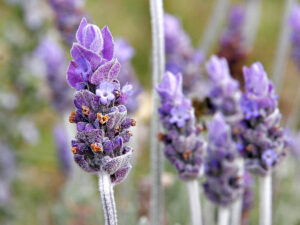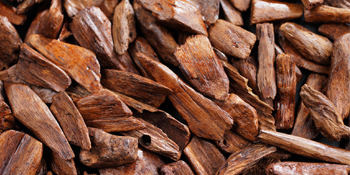Why We Need Skin
What we can see and touch of our skin is just the surface of a complex structure that carries out many functions. For instance, our skin acts as the first line of defence against harmful micro-organisms. It plays an important part in helping maintain body temperature and in balancing out levels of water and minerals. The skin can absorb some small fatty molecules (hence its ability to absorb essential oils in carrier oils) but not too many water based substances. The skin's ability to detect heat, cold and pain alerts the brain to possible danger. The skin also reacts to pleasurable sensations like touch.
The upper layer of the skin is called the epidermis. New cells are constantly being produced at the base of this layer which push older ones to the surface. As the old cells are forced up they harden and die, a process called keratinization. By the time there calls reach the top of the epidermis they are dead, flat and dry, and will be shed to make way for others. The rate of cell renewal becomes slower with age.
The lower layer of skin is the dermis. It consists of a gel-like substance strengthened by interwoven fibres of two proteins, collagen and elastin. Collagen provides strength and support, while elastin provides flexibility. The rate at which these proteins are replaced slows as part of the ageing process too, resulting in the loss of firmness and elasticity we call wrinkling.

The dermis contains all the main skin structures, such as hairs, which grow our of follicles, and the sebaceous glands attached to the hair follicles, which produce our skin's natural lubricant, sebum. The dermis also houses the different types of sweat gland that help rid the body of wastes and give rise to bodily odour, the nerves connecting skin with the brain, and the tiny blood and lymphatic vessels taking nutrients to and removing wastes from the skin.
Stress and the Skin
The skin can act as a reflection of the internal health of the body. Among others things it is sensitive to changes in the circulation, hormones and emotions and if any major organ or system is imbalanced, the skin will start to show signs of this. Sudden, severe stress can have dramatic effects on the skin, as one of the body's first actions when under threat is to limit the blood supply to the skin in favour of more important organs like the heart and lungs. Someone who is frightened or shocked will look pale as blood is diverted from the skin. If stress continues long term it can weaken the immune system and cause changes in the nervous and hormonal systems. This can disrupt normal skin function and health and lead to problems ranging from excessive oil production and acne to a tendency to allergic conditions like eczema.
Stress, especially on a long-term basis, encourages skin ageing. Sun exposure, poor nutrition and an unhealthy lifestyle will also have an ageing effect. Aside from relieving stress, most dermatologists agree that the single most effective step we can take against skin ageing is to use a factor 15 sun block daily. Eating fresh foods, especially fruit, vegetables, nuts and seeds, with high levels of enzymes, vitamins an minerals is also important.
Smoking causes collagen fibres in the facial skin to break down more rapidly, leading to premature wrinkling, and reduces oxygen levels in the skin which gives a sallow, tired appearance. Regular, adequate sleep allows maximum cellular regeneration to take place.
Skin-friendly Essential oils
Essential oils may have a stronger effect on disturbed skin, so choose ones that are 'skin-friendly' and never those known to be irritant. Three of the most gentle yet effective essential oils for the skin are roman chamomile, lavender and sandalwood.
Roman Chamomile is an excellent anti-inflammatory and soothing oil, as well as being highly antiseptic. It helps calm skin conditions where there is itching and irritation and is mentally comforting, which may help those suffering stress-related skin problems.


Lavender promotes skin healing as well as being calming and anti-inflammatory. It can help speed the healing of blemishes, bruises and other minor skin problems, and is also very antiseptic. Emotionally it has a balancing and sedative effect.
Sandalwood is soothing and lubricating, ideal for dry, rough, chapped and sensitive skins. It can help to gently improve circulation in skins suffering from high colour and flushing. Mentally it is 'grounding' and calming for anxiety and tension.

Essential Oils and Skin
Essential oils can work extremely well on a range of skin conditions, as their holistic nature can address the underlying causes as well as the symptoms of skin problems. When used on the skin they have a range of actions - some are anti-inflammatory, helping to calm the skin, some help to reduce itching, some have antifungal properties and most have antibacterial effects. Many also aid healthy skin circulation. Through their aromas they may help to dispel the feelings of fear, stress and anxiety that can contribute to the actual skin imbalance itself.
When using essential oils for skin problems, a light and gentle application is usually more appropriate than a vigorous massage. Blends may be used morning and night as required or a compress can be applied, especially if the skin is too sensitive to be disturbed by even a gentle massage. For conditions where there is heat or itching, such as eczema, a cool compress is more suitable. Where the circulation needs increasing, a warm compress is preferable. If the skin condition is wide-spread, an aromatic bath gives the opportunity for essential oils to reach the whole body, as well as being relaxing and allowing a powerful release of aromas which affect the mind and emotions. Aromatic baths can be taken daily and evening use is a helpful aid to sleep.